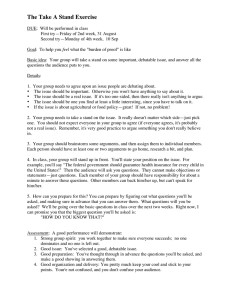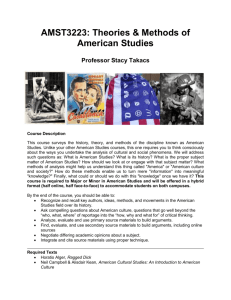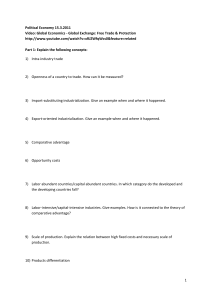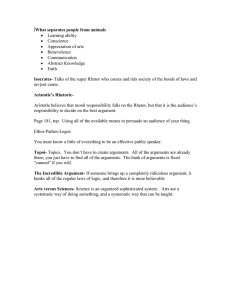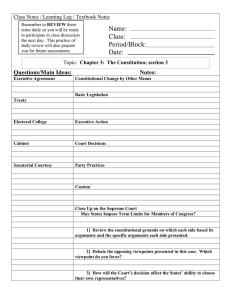Spousal Money Arguments Insights from Non-Cooperative Game Theory and the NLSY Abstract
advertisement
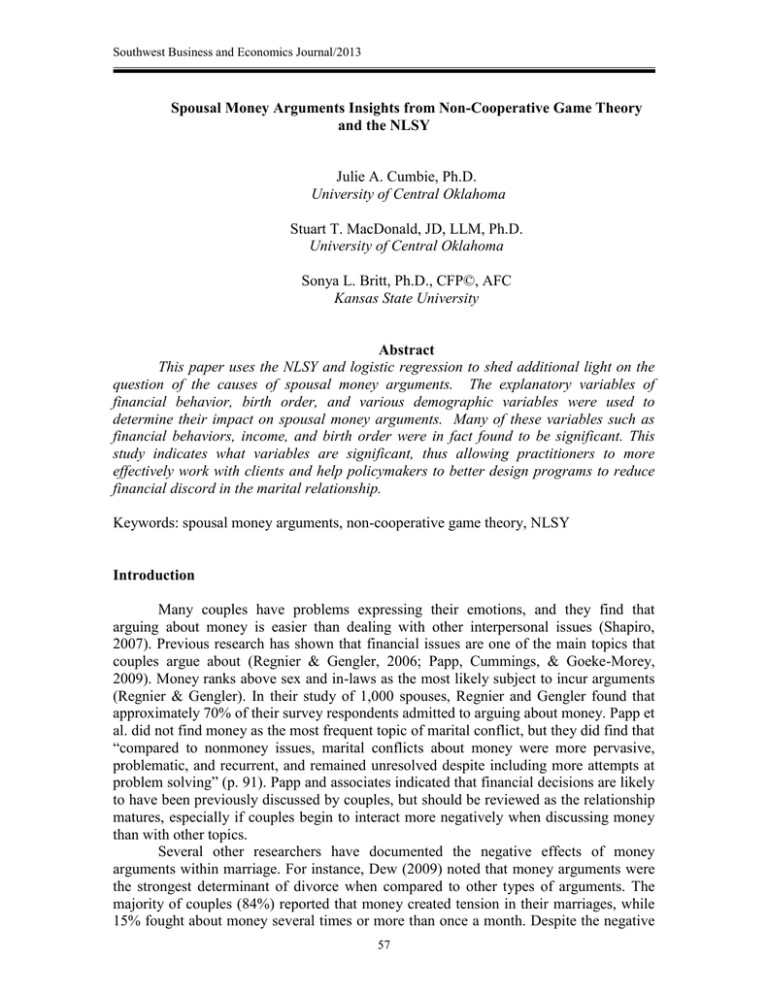
Southwest Business and Economics Journal/2013 Spousal Money Arguments Insights from Non-Cooperative Game Theory and the NLSY Julie A. Cumbie, Ph.D. University of Central Oklahoma Stuart T. MacDonald, JD, LLM, Ph.D. University of Central Oklahoma Sonya L. Britt, Ph.D., CFP©, AFC Kansas State University Abstract This paper uses the NLSY and logistic regression to shed additional light on the question of the causes of spousal money arguments. The explanatory variables of financial behavior, birth order, and various demographic variables were used to determine their impact on spousal money arguments. Many of these variables such as financial behaviors, income, and birth order were in fact found to be significant. This study indicates what variables are significant, thus allowing practitioners to more effectively work with clients and help policymakers to better design programs to reduce financial discord in the marital relationship. Keywords: spousal money arguments, non-cooperative game theory, NLSY Introduction Many couples have problems expressing their emotions, and they find that arguing about money is easier than dealing with other interpersonal issues (Shapiro, 2007). Previous research has shown that financial issues are one of the main topics that couples argue about (Regnier & Gengler, 2006; Papp, Cummings, & Goeke-Morey, 2009). Money ranks above sex and in-laws as the most likely subject to incur arguments (Regnier & Gengler). In their study of 1,000 spouses, Regnier and Gengler found that approximately 70% of their survey respondents admitted to arguing about money. Papp et al. did not find money as the most frequent topic of marital conflict, but they did find that “compared to nonmoney issues, marital conflicts about money were more pervasive, problematic, and recurrent, and remained unresolved despite including more attempts at problem solving” (p. 91). Papp and associates indicated that financial decisions are likely to have been previously discussed by couples, but should be reviewed as the relationship matures, especially if couples begin to interact more negatively when discussing money than with other topics. Several other researchers have documented the negative effects of money arguments within marriage. For instance, Dew (2009) noted that money arguments were the strongest determinant of divorce when compared to other types of arguments. The majority of couples (84%) reported that money created tension in their marriages, while 15% fought about money several times or more than once a month. Despite the negative 57 Spousal Money Arguments Insights from Non-Cooperative Game Theory and the NLSY effects of money arguments on the likelihood of divorce, money arguments appear to be even more predictive of relationship satisfaction than divorce (Britt & Huston, 2012), possibly indicating high occurrences of unhappy relationships due to spousal arguments about money. Money is also a contentious topic among cohabiting couples. Relationship problems associated with financial issues contribute to the dissolution of cohabiting unions (Dew, 2011). This study expands the literature base related to a prediction of money arguments by examining the relationships between the frequency of money arguments and one’s financial behaviors, human capital, and various demographic variables, including birth order. Although several intra-household bargaining approaches have been used to explore spousal money arguments, the current study focuses on a non-cooperative bargaining approach. From a non-cooperative bargaining perspective (Lundberg & Pollak, 1994), spouses attempt to maximize their individual utilities without regards to the overall household utility. In other words, individuals are assumed to be concerned with the satisfaction that they personally derive from consuming a good or service. As discussed in the sections that follow, there is evidence to suggest that firstborns, those with certain financial behavioral characteristics, and those with higher human capital may have a preference toward maximizing individual utility and may therefore have a higher frequency of money arguments. This study attempts to answer the later part of the previous sentence by exploring if spouses who have a known preference for individual utility do indeed argue more about money. Theoretical Framework and Related Literature Economists have long struggled with the issue of how to apply unitary/single utility functions to household expenditures (Browning & Chiappori, 1998). The first major contribution in applying the unitary utility function to joint decision making was Samuelson’s concept of a household welfare function (Samuelson, 1956). While useful, this utility function still relied on transferable preferences and the weighting of each member’s utility. From both a theoretical and empirical perspective, these assumptions can be problematic. The next breakthrough was made by Becker (1991) relying heavily on Gronou’s (1973) work on the allocation of time within a family. At its heart, Becker’s work borrows from the framework of a production function in which the family is cooperating to manufacture the greatest quantity of market and household goods to provide utility to the household (Becker, 1991). This work, while solving many mathematical issues associated with modeling a family’s allocation of resources also relied on almost complete cooperation, low to no transaction costs, and universally positively intercorrelated utility functions among family members (Konrad & Lommourd, 2000). While undeniably mathematically elegant, Becker’s solution may rely on assumptions too rigorous to accurately reflect many marital relationships. However, building on the work of Becker and Samuelson, game theorists have developed cooperative and non-cooperative bargaining models that can still stand the rigor of being proved mathematically and yet still more accurately capture the reality of many marriages. Becker’s (1991) analysis of marriage begins by examining the marriage market. Like any other market, if negotiations could occur without significant transaction costs and enforceable agreements could be negotiated, not only would the initial allocation of resources be determined by who marries whom, but also the distribution of resources 58 Southwest Business and Economics Journal/2013 throughout the life of the marriage could be efficiently determined at the outset of the marriage (Lundberg & Pollak, 1994). However, finding a mate is obviously a process with significant transaction costs and search costs, and marriage contracts are notoriously difficult to enforce. When the above conditions cannot be met, non-cooperative game theory can effectively capture the reality of the situation. Unlike cooperative game theory, non-cooperative game theory makes no assumptions that a husband and wife can enter costless, binding, and enforceable agreements. This approach focuses on self-enforcing agreements in which the solution is the Nash equilibrium (both parties get what resources they want). Such models do not assume or imply that all equilibria are Pareto optimal (i.e., when it is impossible to put one person in a better position by giving them more resources without putting someone else in a worse position) as does cooperative game theory (Lundberg & Pollak, 1994). The assumptions of traditional non-cooperative game theory do open the door to examining negotiations within marriage. Thus, the approach suggested by Lundberg and Pollak that manages to combine elements of cooperative with non-cooperative game theory may more accurately capture marriage. Lundberg and Pollak noted that in many marriage negotiations, both cooperative and non-cooperative, Nash equilibria can be supported. Pareto optimal outcomes can occur even without binding agreements as solutions to repeated games. They noted that because of the repetitive nature of interactions within any marriage there may well be a tendency towards cooperation. This tendency to be able to maintain a cooperative equilibria within a repeated interaction is strongly supported by both empirical and experimental work dealing with iterated prisoners’ dilemma games: “if the prisoner’s dilemma is repeated as a stage game forever, then it is well known that the cooperative outcome (“don’t confess”) is an equilibrium despite the inability of the players to make binding agreements” (Lundberg & Pollak, p. 134). Browning and Chiappori (1998) also demonstrated empirically that within marriage, cooperative outcomes can be sustained. However, in order for these outcomes to be sustained, each party must have a credible threat or a way to punish the partner that deviates from the cooperative outcome. This study posits that disagreements about money that turn into arguments about money are an example of the parties disciplining one another for deviating from the cooperative equilibrium distribution of resources within a marriage. Therefore, it would be expected that couples with more positive financial behaviors have more clearly delineated the cooperative equilibria resource distribution and thus recourse to the disciplining mechanism of verbal confrontation will be used less. Guided by the work of Lundberg and Pollak (1994) described above, and using control variables described below, the following model will be tested: Frequency of money arguments f (financial behaviors, human capital, birth order, age) Financial Behavior Characteristics Despite women’s advances in the work force, husbands and wives still conduct financial tasks along traditional lines where women manage the daily household finances and men handle the long-term planning (Regnier & Gengler, 2006). Subsequently, it is possible that money arguments will increase in frequency if men and women deviate from their traditional roles. 59 Spousal Money Arguments Insights from Non-Cooperative Game Theory and the NLSY Despite women’s independent access to money through employment, the decline of men’s traditional role of the breadwinner, and the increase in cohabiting couples, inequalities in control over finances still exist (Vogler, Lyonette, & Wiggins, 2008). One source of financial conflict for couples is related to purchasing large expenditures. Women have typically been assigned to make domestic purchases and men to make purchasing decisions of technical items. Deviations from these traditional purchases can lead to conflict (Kirchler, 2011). Other financial behaviors, such as the overexpenditure of money and the blaming and hostility of these behaviors between family members, may also lead to conflict (Papp et al., 2009). Perceptions of spousal financial behaviors are oftentimes more important than actual behaviors. Respondents who perceived their partner’s spending behaviors negatively were more likely to report lower satisfaction with their relationship (Britt, Grable, Nelson, & White, 2008). According to their study of 133 married adults, Lawrence, Thomasson, Wozniak, and Prawitz (1993) found several financial behaviors positively related to the frequency of arguing about money. Delaying tactics, apparel cost-cutting strategies, and do-ityourself techniques were related to more frequent arguments. Among other behaviors, those respondents that put off purchasing needed services or who contacted creditors about late bills were more likely to argue. Several of these practices are similar to the financial behaviors used in the current study in order to conceptualize overall positive or negative financial behaviors. Referring back to the conceptual model, in addition to financial behaviors, human capital is also considered to influence the frequency of money arguments. Human Capital Attained human capital is comprised of those attributes in which individuals seek to optimize their utility through the attainment of higher levels of education and income (Becker, 1993). Higher incomes are associated with less frequent money arguments (Britt & Huston, 2012; Goodman, 1986). Well-educated individuals generally possess more effective communication skills which help reduce relationship stress (Amato & Previti, 2003), whereas lower levels of education and income may represent economic pressure and be used to predict marital conflicts (Dew & Yorgason, 2010). In contrast, in a sample of retirement age couples, Lawrence et al. (1993) found that disagreements about money exist regardless of income or education. Konrad and Lommerud (2000) suggested that spouses have an incentive to overinvest in their education, which may increase their income, and improve their bargaining power within their relationship. Spouses with greater bargaining power may be able to allocate additional resources to maximize individual utility. Consequently, it is reasonable to assume that working age couples with higher income and higher levels of education (i.e., those with higher attained human capital) may choose to allocate resources for individual purposes to further their utility in the threat point (i.e., money arguments). In regards to endowed human capital, I.Q. has been shown to be an accurate proxy for endowed human capital, and a strong relationship between I.Q. and financial decision making exists (Finke, 2009). People with higher levels of endowed human capital are expected to maximize their individual utility functions and engage more frequently in money arguments. Based on non-cooperative game theory (Lundberg & Pollack, 1994), people with higher endowed human capital maintain more bargaining power and ability to influence the threat point. Consequently, according to a noncooperative theoretical framework, individuals with higher endowed human capital argue 60 Southwest Business and Economics Journal/2013 more about money with their spouse in an attempt to allocate more resources to individual utility. Birth Order and Age Finally, birth order and age are thought to influence money arguments. A number of birth order studies have been conducted in economic, social, and psychological research with various results. Economic studies have found strong evidence that birth order has effects on income, educational attainment, and I.Q. Firstborns or earlier born children have higher educational attainment, higher earnings, and higher I.Q.’s than laterborn children (Black, Deveraux, & Salvanes, 2005; 2011). Black et al. (2005) observed a steady decline in children’s education by birth order; a higher birth order had a significant and large negative effect on educational attainment. Furthermore, results showed that both laterborn women and men have lower full-time earnings. Sulloway (1996) developed the “niche model of personality development” which suggests that firstborn children have the first choice of niche and strive to impress their parents in traditional ways by assuming responsibility and other achievements. His model proposed five factors of personality dimensions: Surgency, Agreeableness, Conscientiousness, Emotional Stability, and Openness. Sulloway found that firstborn status was positively correlated with Surgency and Conscientiousness and negatively correlated with Agreeableness, Emotional Stability, and Openness while controlling for sex, age, number of siblings, and socioeconomic status. Michalski and Shackelford (2002) replicated Sulloway’s study with contradicting results, with the exception of Agreeableness (i.e., firstborn children are less agreeable) which was also found to have a negative relationship with firstborn status. Adler (1931) proposed the dethronement theory in which firstborns are afraid of being dethroned by their younger siblings and will fight to maintain their authoritative position in the family. The firstborns may want to control their siblings through the use of effective argument (Rodgers, 2003). In fact, Rodgers hypothesized that firstborns and only children would report more argumentativeness than laterborns. Results indicated that firstborns reported significantly greater argumentativeness than did the youngest children. These results suggest that firstborn children will report more spousal money arguments than laterborn children. Age has been determined to be an important indicator of money arguments (Goodman, 1986; Lawrence et al., 1993). In his study of 2,555 randomly sampled adults who have the role of the families’ chief financial decision makers, Goodman found that as age increased, respondents argued more about nonmonetary issues than financial ones. Utilizing a smaller sample of 133 older married adults, Lawrence et al. (1993) determined that the frequency of arguing about money decreased significantly as age increased. Based on the research literature and proposed theoretical framework, the following hypotheses will be tested: H1: Spouses with more negative financial behaviors argue more frequently about money. H2: Spouses with higher attained and endowed human capital argue more frequently about money. H3: Firstborns argue more frequently about money. H4: Younger spouses argue more frequently about money. 61 Spousal Money Arguments Insights from Non-Cooperative Game Theory and the NLSY Methods Respondent data was retrieved from the National Longitudinal Survey of Child/Young Adult (1986-2008) administration which profiles the development of all children born to the National Longitudinal Survey of Youth 1979 (NLSY79) cohort female respondents. This child survey, conducted biennially, includes comprehensive respondent data, coupled with longitudinal information on the family background, education, employment histories, and economic well-being of their NLSY79 mothers. This data set provides variables to measure money arguments, financial behaviors, human capital, and various demographic characteristics, making it an appropriate data set for this study. Dependent Variable This study hypothesized that the actual causes and frequencies of arguments about money are, in fact, an unobservable latent variable indicating many facets and issues in the underlying relationship. When dealing with a latent variable, a researcher must use data that is observable to draw conclusions about the underlying latent variable. As Long (1997) argued in his seminal work on limited and dichotomous dependent variables, logit is often appropriate when a researcher suspects they are dealing with a latent variable. Long argued that if logistic regression is appropriate for a particular research question, that is evidence that one is dealing with a latent variable. In specifying this model, this study recognized the observed limited dependent variable, frequency of money arguments. This variable was reported on a Likert scale ranging from 1 (often argues about money) to 4 (never argues about money). However, from an econometric standpoint, this is arguably not a ratio level of measurement. One respondent’s definition of frequent might meet another respondent’s definition of sometimes. Ratio data relies on equal variance between the units for all respondents. In this study, this issue is dealt with by recoding the dependent variable as a 0, 1 dichotomous variable. Respondents reporting to often (1) or sometimes (2) argue about money were recoded as 1, while those respondents reporting to hardly ever (3) or never (4) argue about money were recoded as 0. Independent Variables Financial Behaviors Financial behaviors were measured by a summation of a three-item scale based on the following questions: (a) How often do you/does your household put off buying something you need, such as food, clothing, medical care, or housing because you don’t have money?; (b) During the past 12 months, how much difficulty did you/did your household have paying bills?; and (c) Thinking about the end of each month over the past 12 months, how much money did you/did your household have left over? The first two questions allowed for five responses and the last question allowed for four responses, resulting in a possible range of scores of 3 to 14. The responses were coded so that a higher score represented more negative financial behaviors. Similar to Perry and Morris’ (2005) inquiry, the current study uses a self-reported measurement of financial behavior outcomes these outcomes will be referred to simply as financial behaviors. 62 Southwest Business and Economics Journal/2013 Human Capital Intelligence Quotient (I.Q.) was used to measure each respondent’s endowed human capital. I.Q. was measured continuously from the results of the 1986 administration of the Peabody Picture Vocabulary Test, Revised (PPVT-R). According to the NLSY79 Child and Young Adult Data User’s Guide (2009), the PPVT-R is one of the “best-established indicators of verbal intelligence and scholastic aptitude across childhood” (p. 114). Due to evidence of skewness, I.Q. was transformed to a logarithm. Respondents’ education and income were used as proxies to measure the respondents’ attained human capital. Both variables were measured on a continuous variable basis using data from the 2008 administration of the NLSY Child/Young Adult (1986-2008) survey. For ease of interpretation, income was divided by 1,000. Demographics Age was measured continuously. Applying the logic of previous researchers that firstborns argue more than laterborns (Michalski & Shackelford, 2002; Rodgers, 2003; Sulloway, 1996) and following the same analysis (Michalski & Shackelford; Sulloway), birth order was coded by combining the NLSY 1986-2008 cohort categories of secondborn or higher to create two categories with firstborn coded as 1 and laterborn coded as 0. As explained above, the dependent variable was unobservable; thus ordinary least squares regression would be inappropriate. It is assumed that the error terms are logistic and thus a logit model is appropriate. The model is specified as follows, where: Sum of financial behaviors, ∑ I.Q., Education, Income, Age, and Birth order. Thus, The Frequency of Money Arguments = β + β∑finbeh + βIQ + βed +βinc + βage + βbthord + εi The frequency of money arguments was measured as a function of one’s summation of financial behaviors, I.Q., education, income, age, and birth order. According to the correlation matrix, no multicollinearity issues were found. Results Descriptive Statistics Results from the descriptive statistics analysis (Table 2.1) showed an approximate 44% - 56% split between those respondents who often or sometimes argue about money and those who hardly ever or never argue about money. With a range from 3 to 14, the mean score for financial behaviors was 6.68. The mean I.Q. for respondents was 3.99 (range = 1.6 - 4.95). Average level of education was approximately 13 years (range = 7 20 years), and the mean income for respondents was $28,362 (range = $0 - $125,000). The sample consisted of approximately 52% males and 48% females with an average age of 27 years (range = 18 - 35). Fifty-two percent of respondents were firstborns and 48% were laterborns. 63 Spousal Money Arguments Insights from Non-Cooperative Game Theory and the NLSY Table 2.1: Descriptive Statistics of the Sample Essay 1 N =851 Variable Money Arguments 1 = Often/Sometimes 0 = Hardly ever/Never Sum of Negative Financial Behaviors Mean (Range) I.Q. Mean (Range) Education Mean (Range) Income Mean (Range) Age Mean (Range) Birth Order 1 = Firstborn 0 = Laterborn Sex 1 = Male 0 = Female % 377 474 44.30% 55.70% 6.68 (3 - 14) 3.99 (1.61 - 4.95) 12.92 (7 - 20) $28,362 ($0 - $125,000) 27.29 (18 - 35) 52.17 47.83% 51.82% 48.18% Regression In order to predict the likelihood of couples often or sometimes arguing about money or hardly ever or never arguing about money, a logistic regression was developed (Table 2.2). The Log Likelihood Ratio (80.94) was statistically significant for the model at the p < .001 level. Results from the regression model showed that one’s financial behaviors, income, and birth order were statistically significant predictors of their frequency of money arguments. Respondent’s financial behaviors were the largest contributor to the model with a standardized beta estimate of 0.34. Respondents with more negative financial behaviors were 28% more likely to argue with their spouse about money (p < .001). Birth order was the second largest contributor to the model (β = -0.17). According to the regression, laterborns were more likely to argue about money (O. R. = 0.54, p < .001). Finally, when respondents’ income (β = 0.14) increased by $1,000, couples were 1% more likely to argue about money (p < .01). One’s I.Q., education, age, and sex were not found to be statistically significant in predicting the frequency of money arguments. 64 Southwest Business and Economics Journal/2013 Table 1.2: Logistic Regressions – Money Arguments Essay 1 N =851 Variable Coefficient Odds Ratio þ -2.57** O. R. Intercept Sum of negative financial behaviors Log I.Q. Education Income by 1,000 Age Male Firstborn *p <.05, **p < .01, ***p < .001 0.24*** -0.21 -0.01 0.01** 0.06 -0.07 -0.63*** 1.28 0.81 1.00 1.01 1.06 0.94 0.54 Standardized beta estimate β 0.34 -0.07 -0.01 0.14 0.10 -0.02 -0.17 Discussion The current study was conceptualized to test the hypotheses that the frequency of spousal money arguments is influenced by financial behaviors, human capital, birth order, and age. Past research literature indicates that several of these variables may predict the frequency of money arguments (e. g., Lawrence et al., 1993; Goodman, 1986). Hypothesis One was confirmed: Spouses with more negative financial behaviors were more likely to argue about money. Lawrence et al. (1993) used similar financial behaviors related to putting off buying certain items and services and difficulty paying bills. Confirming Lawrence et al.’s findings, the current study also found a significant association between negative financial behaviors and the frequency of money arguments. Arguably, this finding is not surprising. If spouses are engaged in financially responsible behaviors, it would be expected they are acting as a household maximizing unit, which leads to less disagreements. According to Hypothesis Two, the higher one’s attained and endowed human capital, the more frequently one argues about money. This hypothesis was partially confirmed as the only component of human capital found to predict the frequency of money arguments was income. For working respondents, the higher their income, the more likely couples were found to argue about money. This may be interpreted to mean that when there are higher levels of income, more and larger financial decisions may ensue which result in additional negotiations and/or disagreements about money. As this occurs, spouses may employ unitary utility maximizing behavior which creates a noncooperative marital situation and uses money arguments as the threat point. This situation may be in comparison to having just enough money to meet the household’s basic needs which creates a cooperative household in which decisions have to be household maximizing. Similar to Lawrence et al. (1993), education as a form of attained human capital was not found to influence the frequency of money arguments. In addition, endowed human capital as measured by I.Q. was not statistically significant to the model. Based on the past research literature, the current study hypothesized that firstborns were more likely to argue about money (e.g., Adler, 1931; Michalski & Shackelford, 2002; Rodgers, 2003; Sulloway, 1996). In this study, birth order was found to be statistically significant; Hypothesis Three was rejected. 65 Spousal Money Arguments Insights from Non-Cooperative Game Theory and the NLSY The opposite was determined: Laterborns were shown to engage in more frequent money arguments than firstborns. This counterintuitive finding, which runs contrary to prior research, is noteworthy. Two possible explanations present themselves. First, Sulloway (1996) relied on older data gathered when the average family size was larger and being an only child was relatively rare. In fact, Sulloway used data from Ernst and Angst’s (1983) study which was a meta-analysis of previous birth order studies. These studies would presently be about 32 to 66 years old (Harris, 2002). Although Rodgers (2003) and Michalski and Shackelford (2002) found similar results as Sulloway related to argumentativeness and birth order, their sample sizes were relatively small (207 and 438, respectively). This study relied on more modern data (1986 to 2008) gathered when family size is generally smaller. The possibility exists that at the aggregate level, the change in average family size is changing the significance of birth order. As was noted above, being a firstborn child is also highly correlated with other characteristics that are correlated with more positive financial behaviors. These other characteristics may be overwhelming the impact of birth order. For example, though not significant in this study, this study showed that higher I.Q.’s are associated with fewer arguments over money. As higher I.Q. is also associated with higher birth order (Black et al., 2005; 2011), perhaps the impact of higher I.Q. is cancelling out the increased propensity of firstborns to argue. Whatever the case, this finding warrants further investigation in future studies. Although age has been found to have a positive association with the frequency of money arguments (Goodman, 1986; Lawrence et al., 1993), this variable was not significant in predicting money arguments in the current study. One possible explanation for this finding is that in this particular study the ages of the respondents did not vary greatly. The respondents’ ages range from their teens to their 30’s. Perhaps a data set that allowed for more variance in age of the respondents would have produced results that were consistent with other studies. An interesting focus of analysis for a future study might be to attempt to determine whether age functions as a linear variable with a decreased probability of arguing for every year of age or whether age produces an intercept where after a certain threshold the tendency to argue over money falls off. For the purpose of this study, Hypothesis Four must also be rejected. The results of the regression showed that several of the hypothesized variables were predictors of the frequency of money arguments, however, as discussed, not all had the association expected. Overall, the model utilized the theoretical framework indicating that the frequency of money arguments is associated with financial behavior and income. Implications Research related to possible causes of spousal money arguments is limited (Britt et al., 2010). The goal of the current study was to further this span of knowledge by examining various potential predictors of the frequency of money arguments. This was accomplished by conceptualizing money arguments as a threat point in marriage according to Lundberg and Pollak’s (1994) theory of non-cooperative game theory. Such a theoretical framework may provide a mechanism for other researchers and practitioners to further investigate disagreements about money for couples. A benefit of having additional knowledge of the cause of money disagreements exists for practitioners and educators who address couples’ money issues (Dew, 2008). As Papp et al. (2009) noted, raising awareness possibly even before spouses combined their finances, could prevent money related conflicts later in their marriage. In this study, financial behaviors, income, 66 Southwest Business and Economics Journal/2013 and birth order were found to possibly provide insight for the integrated disciplines of financial therapy and financial planning. Financial behaviors are often linked to emotional meanings about money, such as self-worth, security, and respect (Shapiro, 2007). “Thus, when partners have different meanings for money, the disagreements may be strongly related to dissolution because they tap deep emotional issues” (Dew, 2011, p. 181). Financial counselors and planners may not be equipped to assist clients with these types of issues. Therefore, financial therapy may be beneficial for couples before they make any major financial decisions in order to determine what emotional links may exist related to their financial behaviors, whether negative or positive. Financial therapy can be defined as “the integration of cognitive, emotional, behavioral, relational, and economic aspects that promote financial health” (Financial Therapy Association, 2011, p.1). Exploring each partner’s financial behaviors and any underlying causes for these behaviors may aid in establishing a joint utility maximizing marital situation and lead to less contention about money matters. Knowing that specific financial behaviors may be a cause for dissension within a marriage, may help financial therapists to identify those variables that lead to such behaviors. Perhaps, even raising clients’ awareness of their own motivations could reduce future negative behaviors. Interesting and helpful to financial counselors and planners is the finding that higher respondent’s income leads to more frequent money arguments. When counseling or establishing a plan for couples, the practitioner should take into consideration not only the economic aspects related to income, but possibly the function that money plays within the household. Is the couple maximizing the household utility or, due to the fact that there is more money available, are they actually seeking to maximize their own utility? In an actual practice, it is quite likely that a financial planner will see instances of both behaviors. Therefore, being aware of clients’ possible motivations will increase the planner’s ability to effectively assist their clients. Results also indicate that financial professionals may want to consider the birth order of their clients. Although this is a new concept to the area of financial planning, the study suggests that this information may help professionals in identifying certain individuals and their propensity to create conflict within their relationships. Overall, collaboration between financial therapists and financial planners is necessary in order to fully benefit many clients. Planners and therapists have different sets of skills and areas of experience and expertise, which when integrated improve the planning process (Maton, Maton, & Martin, 2010). “We position the planner/financial therapist collaboration as a way for clients to learn more about themselves and their money” (Maton et al., p. 65). Due to this requirement for close collaboration between financial planners and financial therapists, studies that shed light on the motivations of clients, and the predictors for these motivations will be useful to both financial planners and therapists. Limitations and Recommendations While this data set is valuable in that it allows a researcher to capture some behaviors, it does have limitations. First, other data sets may allow for a more defined measurement of financial behaviors. The current study uses responses to the following three questions in order to assess financial behaviors: (a) How often do you/does your household put off buying something you need, such as food, clothing, medical care, or housing because you don’t have money?; (b) During the past 12 months, how much 67 Spousal Money Arguments Insights from Non-Cooperative Game Theory and the NLSY difficulty did you/did your household have paying bills?; and (c) Thinking about the end of each month over the past 12 months, how much money did you/did your household have left over? Other variables may give more clear insight into one’s actual financial behaviors. In addition, these responses are self-reported, which may cause sample bias. When assessing birth order, the data does not account for the fact that many respondents may come from blended families, and family size varies. If so, this may impact the birth order effect differently. In addition, the birth order for each individual spouse may have an influence on the results of the study. These considerations provide interesting areas for further research. These data only measure the frequency of money arguments and do not consider the severity of these arguments. Frequent arguments of limited duration that do not necessarily place serious stress on a marriage are obviously a quite different matter than infrequent arguments that seriously stress a marriage and may leave one party contemplating utilizing a serious threat point. Perhaps other data sets may provide more detailed information related to money arguments. These responses are also self-reported, which may bias the sample. An additional limitation of this study is that the regression models only included respondents who provided complete data. Those individuals who had missing data were not included in the models and may have reported differently, leading to outcomes not consistent with this study. Finally, the fact that the data for the outcome variable use Likert scales which do not produce true ratio level data has been discussed above. These type of scales inject some imprecision into data when a researcher is using regression analysis. Although this study has limitations, it definitely provides some other areas for further research. This study indicates that further analysis of birth order data is warranted to determine whether changes in average family size and child rearing practices call into question prior beliefs about birth order based on older data. This study also has another finding that would be of great significance to financial planners and financial therapists: the fact that increased levels of income tend to lead to an increase of arguing over money indicates that as clients move towards their financial goals and command greater resources, professionals must be prepared for their clients’ interactions over money to become more contentious. As couples’ income increases, introducing them into financial planning may actually be more conducive to marital satisfaction. In addition, mandatory premarital counseling may be a consideration to reduce spousal money arguments. This study provides useful information to practitioners and policymakers and opens up intriguing areas of further research. 68 Southwest Business and Economics Journal/2013 References Adler, A. (1931). What life should mean to you. Boston: Little, Brown, and Company. Amato, P. R., & Previti, D. (2003). People’s reasons for divorcing: Gender, social class, the life course, and adjustment. Journal of Family Issues, 24(5), 602-626. Becker, G. S. (1991) A treatise on the family. Cambridge, MA: Harvard University Press. Becker, G. S. (1993). Human capital: A theoretical and empirical analysis with special reference to education, 3rd ed. Chicago and London: The University of Chicago Press. Black, S. E., Devereux, P. J., & Salvanes, K. G. (2005). The more the merrier? The effect of family size and birth order on children’s education. The Quarterly Journal of Economics, 120(2), 669-700. Black, S. E., Devereux, P. J., & Salvanes, K. G. (2011). Older and wiser? Birth order and IQ of young men. CESifo Economic Studies, 57(1), 103-120. Britt, S., Grable, J. E., Nelson Goff, B. S., & White, M. (2008). The influence of perceived spending behaviors on relationship satisfaction. Financial Counseling and Planning, 19(1), 31-43. Britt, S. L., & Huston, S. J. (2012). The role of money arguments in marriage. Journal of Family and Economic Issues. doi: 10.10007/S10834-012-9304-5 Browning, M., & Chiappori, P. (1998). Efficient intra-household allocations: A general characterization and some tests. Econometrica, 66, 1241-1278. Dew, J. (2009). The gendered meanings of assets for divorce. Journal of Family and Economic Issues, 30(1), 20-31. Dew, J. (2011). Financial issues and relationship outcomes among cohabiting individuals. Family Relations, 60(2), 178-190. Dew, J., & Yorgason, J. (2010). Economic pressure and marital conflict in retirementaged couples. Journal of Family Issues, 31(2). 164-188. Ernst, C., & Angst, J. (1983). Birth order: Facts and fiction concerning its influence on personality: A survey of the literature, 1946-1980, followed by a study of a representative young adult population. Berlin and New York: Springer-Verlag. Financial Therapy Association. (2011). Retrieved from http://www.financialtherapyassociation.org/ Goodman, M. (1986). Americans and their money: 1986. Money, 15(11), 159-166. Gronau, R. (1973). The intrafamily allocation of time: The value of housewives’ time. American Economic Review, 63, 634-651. 69 Spousal Money Arguments Insights from Non-Cooperative Game Theory and the NLSY Harris, J. R. (2002). The mystery of Born to Rebel: Sulloway’s re-analysis of birth order data. Retrieved from https://www.judithrichharris/tna/birth-order/index.htm Kirchler, E., Rodler, C., Holzl, E., & Meier, K., (2001). Conflict and decision making in close relationships. Hove: The Psychology Press. Konrad, K. A., & Lommerud, K. E. (2000). The bargaining family revisited. The Canadian Journal of Economics, 33(2), 471-487. Lawrence, F. C., Thomasson, R. H., Wozniak, P. J., & Prawitz, A. D. (1993). Factors relating to spousal financial arguments. Financial Counseling and Planning, 4, 8594. Long, J. S. (1997). Regression models for categorical and limited dependent variables. Thousand Oaks, CA: Sage. Lundberg, S., & Pollak, R. A. (1994). Noncooperative bargaining models of marriage. The American Economic Review, 84(2), 132-137. Maton, C. C., Maton, M., & Martin, W. M. (2010). Collaborating with a therapist: The why, who, what, and how. Journal of Financial Planning, 23(2), 62-70. Michalski, R. L., & Shackelford, T. K. (2002). An attempted replication of the relationships between birth order and personality. Journal of Research in Personality, 36, 182-188. NLSY Child and Young Adult Data User’s Guide (2009). Retrieved from http://www.nlsinfo.org/usersvc/Child-Young-Adult/2004ChildYA DataUsersGuide.pdf Papp, L. M., Cummings, E. M., & Goeke-Morey, M. C. (2009). For richer, for poorer: Money as a topic of marital conflict in the home. Family Relations, 58(1), 91-103. Perry, V.G., & Morris, M.D. (2005). Who is in control? The role of self-perception, knowledge, and income in explaining consumer financial behavior. The Journal of Consumer Affairs, 39(2), 299-31. Regnier, P., & Gengler, A. (2006). Men women + money. Money, 35(4), 90-98. Rodgers, M. F. (2003). The influence of birth order on verbal aggressiveness and argumentativeness. Unpublished manuscript, Department of Communication Studies, West Virginia University, Morgantown, West Virginia. Samuelson, P. A. (1956). Social indifference curves. Quarterly Journal of Economics, 70(1), 1-22. Shapiro, M. (2007). Money: A tool for couples therapy therapeutic. Family Process, 46(3), 279-291. Sulloway, F. J. (1996). Born to rebel. New York: Pantheon. 70 Southwest Business and Economics Journal/2013 Vogler, C., Lyonette, C. & Wiggins, R. D. (2008). Money, power and spending decisions in intimate relationships. The Sociological Review, 56(1), 117-143. 71
